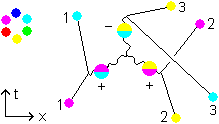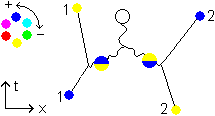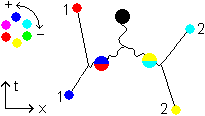application 1
Fig 3.2 at page 3 of the storyline QCD. Use the gluon table.
In an antibaryon two baryonic gluons are emitted simultaneously.

 *
*  = ki = j (6.1)
= ki = j (6.1)
 *
*  = ik = -j (6.2)
= ik = -j (6.2)
(6.1) and (6.2) superpose and cancel out,
(j) + (-j) = 0
The shown outcome  = -j is only one of the two outcomes j and -j.
= -j is only one of the two outcomes j and -j.
Application 2
Fig 3.11 at page 3 of the storyline QCD.
In a meson two mesonic gluons are emitted simultaneously.

 *
*  = -1 * -1 = 1 (6.3)
= -1 * -1 = 1 (6.3)
 *
*  = -1 * -1 = 1 (6.4)
= -1 * -1 = 1 (6.4)
The two gluon multiplications (6.3) and (6.4) superpose...
1 + 1 = 2
...and double their value in the wavefunction.
The meson has changed from 
 to
to 
 which is the usual color swap in mesons.
which is the usual color swap in mesons.
The resulting mesonic gluon escapes, since it has no color and does not leave behind a colored situation.
Its quaternion value is 1, it is an ordinary glueball. Glueballs are not formed abundantly in this process because its creation costs a lot of energy that usually is not available.
Application 3
Fig 3.10 at page 3 of the storyline QCD.
What happens when in a meson two baryonic gluons are emitted simultaneously?

 *
*  = -j * -j = -1 (6.5)
= -j * -j = -1 (6.5)
 *
*  = -j * -j = -1 (6.6)
= -j * -j = -1 (6.6)
The two gluon multiplications (6.5) and (6.6) superpose...
-1 -1 = -2
...and double their value in the wavefunction.
The meson has changed from 
 to
to 

The resulting mesonic gluon escapes, since it has no color and does not leave behind a colored situation. Well, that is, if energy is available to give it its mass. Its quaternion value is -1.
The free mesonic gluon is a glueball-like object with the ability to apply a CPT-like transformation on any quark or antiquark it encounters. It multiplies the quark's color by -1, changes the direction of time and swaps its spin. When an ordinary glueball (quaternion value +1) is called white, then the free mesonic gluon (quaternion value -1) is a black glueball.
If a black glueball is absorbed by a quark in an ordinary baryon or antibaryon or meson, it would leave behind a colored end state. Something like this is not observed. We continue the view that nature will prevent a colored end state from arising. Therefore OR the particle does not exist/ is forbidden; OR it passes by any ordinary quark or antiquark on its way. Also the gluons will be passed by as far as the meeting would lead to a colored end state. This is a new kind of particle within the reach of the standard model, predicted by the quaternion approach.
Black glueballs might be created in large numbers when density is high and energy is abundant, like in the beginning of the universe. Once created, the black glueball seems stable. And when temperature drops and matter became sparse they had no way to dissolve.
Is the black glueball a candidate for Dark Matter? (column at the right, at page 2 of THE EXPANSION OF THE UNIVERSE)